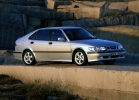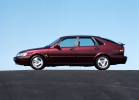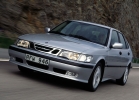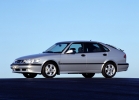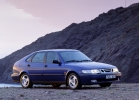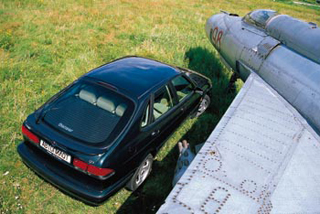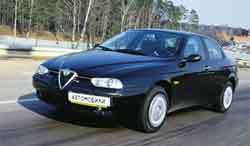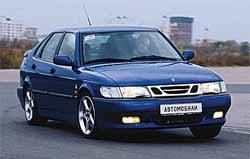Saab test drive 9-3 1998-2002 sedan
The pursuit of a smile
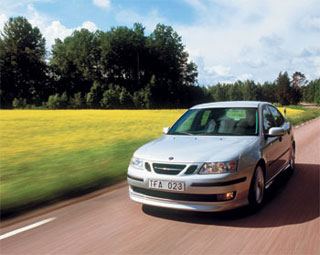 They say that large corporations destroy the individuality of small brands. You will understand that this is not so by looking at the new Saab 9-3.
They say that large corporations destroy the individuality of small brands. You will understand that this is not so by looking at the new Saab 9-3. I always loved this brand: first for an unusual design, then, when I began to understand the technique, for the originality of the design. Like all fans of the Swedish road aircraft, I was anxiously waiting for what would happen to the cars after Saab would flush into General Motors. Then it was clear that otherwise the brand could not survive: in order to afford to develop original models, selling less than 100 thousand cars a year, it is necessary to set prices at them at the Porsche or Maserati level. It is not surprising that the last 900, which later became the first 9-3, had a common platform with Opel Vectra. True, GM experts prefer another term for this - general architecture. The fact that the new Saab 9-3 will also be unified with the current Vectra to some extent was obvious. Meanwhile, Saab, whatever one may say, should remain a bright personality. And the new 9-3 justified hopes!
 Subtle work. At the predecessor, 9-3, the issue of continuity was solved simply-in its design, elements of the style of the classic nine hundredth Saab of the seventies and eighties were used to a considerable extent. It’s not bad, but repeating this idea would now be inappropriate. Therefore, if the new 9-3 Sport Sedan reminds someone, then perhaps the older brother is 9-5. But here, the similarity was limited mainly by traditional details like the form of headlights, lanterns and, of course, facing the radiator. Well, the fact that both have a sedan body. As marketers found out, customers of cars in this market segment prefer models with a separate trunk.
Subtle work. At the predecessor, 9-3, the issue of continuity was solved simply-in its design, elements of the style of the classic nine hundredth Saab of the seventies and eighties were used to a considerable extent. It’s not bad, but repeating this idea would now be inappropriate. Therefore, if the new 9-3 Sport Sedan reminds someone, then perhaps the older brother is 9-5. But here, the similarity was limited mainly by traditional details like the form of headlights, lanterns and, of course, facing the radiator. Well, the fact that both have a sedan body. As marketers found out, customers of cars in this market segment prefer models with a separate trunk. In general, it turned out to be a neat, stylish, moderately expensive car without any screaming details, which, nevertheless, is easily recognizable thanks to a characteristic silhouette and a special style. Really thin work!
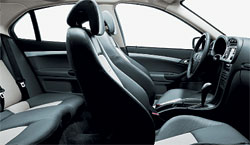 The differences between modifications are minimal. The executions of Linear, Vector and ARC have a salon and engines. Aero top models, which will appear in January, will have a sports suspension with a 10 mm road clearance reduced by 10 mm. Naturally, there will be various wheels. Another element is the set to order a set of aerodynamic hitch, including a spoiler and overlays on the thresholds. In the future, a replenishment of the body of the bodies is expected. It is known that it will include a convertible and a five -door body, but a station wagon or hatchback, Saab is hiding. If we proceed from the traditions of the 900th, it seems to be a hatchback. However, if we recall the main competitors, the station wagon seems more likely.
The differences between modifications are minimal. The executions of Linear, Vector and ARC have a salon and engines. Aero top models, which will appear in January, will have a sports suspension with a 10 mm road clearance reduced by 10 mm. Naturally, there will be various wheels. Another element is the set to order a set of aerodynamic hitch, including a spoiler and overlays on the thresholds. In the future, a replenishment of the body of the bodies is expected. It is known that it will include a convertible and a five -door body, but a station wagon or hatchback, Saab is hiding. If we proceed from the traditions of the 900th, it seems to be a hatchback. However, if we recall the main competitors, the station wagon seems more likely. The range contains three gasoline modifications and one diesel. Diesel is the same as Vectra, quite modern, but they do not plan to supply it to Russia. Gasoline engines are essentially a variation of the same unit. They differ only in turbochargers, the settings of the gas distribution mechanism and the Trionic 8 control system. The similarity of the engines is reflected in the designations of different versions: the most powerful - 2.0t, the one that is more modest - 2.0t, and for the youngest letter designation, they did not come up with, so it became ... 1.8t. Mercedes-Benz with his W201-then it was designated 190, despite the fact that the motor was two-liter, did the same.
 How much 9-3 is similar to the new Vectra? Yes, almost not at all! Different dimensions, different body parameters: for example, Saab mentions that the hardness of the body 9-3 reached 22 kNM per degrees for twisting, and in Vectra this parameter is 18. Also a very good result, but different. Of course, GM did not abandon the idea of \u200b\u200bunification. However, now the construction process is organized a little differently, so in the process of birth, cars created on general architecture diverge much earlier. With Opel, the new Saab divides mainly various additional systems: active head restraints (by the way, now they work at lower speeds-from 15 km/h), a safe pedal node, ESP, emergency braking system, climate control. In general, the individuality of each brand is inviolable!
How much 9-3 is similar to the new Vectra? Yes, almost not at all! Different dimensions, different body parameters: for example, Saab mentions that the hardness of the body 9-3 reached 22 kNM per degrees for twisting, and in Vectra this parameter is 18. Also a very good result, but different. Of course, GM did not abandon the idea of \u200b\u200bunification. However, now the construction process is organized a little differently, so in the process of birth, cars created on general architecture diverge much earlier. With Opel, the new Saab divides mainly various additional systems: active head restraints (by the way, now they work at lower speeds-from 15 km/h), a safe pedal node, ESP, emergency braking system, climate control. In general, the individuality of each brand is inviolable! 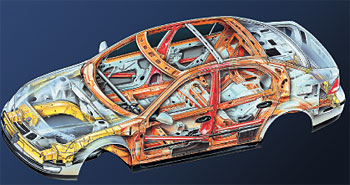 FASTEN SEAT BELTS. For a long time, Saab Automobile AB has nothing to do with Svenska Aeroplan Aktiebolag. And his comparison with the plane somehow ceased to be original ... Nevertheless, the creators themselves are trying to remind of the aviation past from time to time. This, for example, is a comparison of the driver's workplace with the aircraft cab. Or here is such a detail: they resemble the unfamiliar belts that are well familiar to passengers Boeing and Airbus electronic tinkling and the inscription on the display located under the middle of the windshield. So it seems that Ladys and Gentlemen, Captain Speaking will sound now ... And it’s good that it doesn’t sound - it is painfully sorry to give way to someone else.
FASTEN SEAT BELTS. For a long time, Saab Automobile AB has nothing to do with Svenska Aeroplan Aktiebolag. And his comparison with the plane somehow ceased to be original ... Nevertheless, the creators themselves are trying to remind of the aviation past from time to time. This, for example, is a comparison of the driver's workplace with the aircraft cab. Or here is such a detail: they resemble the unfamiliar belts that are well familiar to passengers Boeing and Airbus electronic tinkling and the inscription on the display located under the middle of the windshield. So it seems that Ladys and Gentlemen, Captain Speaking will sound now ... And it’s good that it doesn’t sound - it is painfully sorry to give way to someone else. True, it was not without problems. For example, the steering column adjustment handle had to look. It is located, as usual, below, but far away. But there was a steering wheel adjustment not only in the corner of inclination, but also in the longitudinal direction. The parking brake in the released position is disguised as the same as in the new Honda CR-V. Of course, I didn’t even have to think about the location of the ignition lock at Saab: of course, between the chairs! The designers of the machines explain this by the fact that the possibility of injury to the knee in a collision is completely excluded.
There are a lot of minor governing bodies, and at first such abundance scares. However, in the process it turns out that they are located quite logically and affordable: the choice of what needs to be pressed and twisting is almost intuitive. At first, the shape of the rim of the steering wheel was concerned - it has a clearly expressed rib. However, in a couple of hours it is easy to get used to it.
Well, from the point of view of the passenger there are almost no complaints. The preference in favor of the driver is that the central deflector on the console has separate adjustment only in the direction of the air flow. The right to choose the intensity is entrusted to the driver. It is logical, however, it is quite difficult to ensure the complete separation of climate zones in the cabin.
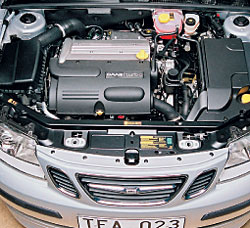 In pursuit of a smile. The first sketch of Saab 9-3 Sport Sedan and the legend accompanying it bypassed, perhaps, the whole world. A smiling driver - this is what is considered the main element of the Saab car. This, in general, is a key idea of \u200b\u200bproper marketing: buying a thing, a person pays primarily for the feelings that he intends to receive from its use.
In pursuit of a smile. The first sketch of Saab 9-3 Sport Sedan and the legend accompanying it bypassed, perhaps, the whole world. A smiling driver - this is what is considered the main element of the Saab car. This, in general, is a key idea of \u200b\u200bproper marketing: buying a thing, a person pays primarily for the feelings that he intends to receive from its use. For tests, cars with two engines were offered: 175-horsepower 2.0t and Aero with 210-horsepower. The configuration of both makes a very pleasant impression. In the range of approximately 2000-5000 revolutions, the engine produces 90 percent of the maximum moment or more. So the car easily moves in almost any gear and is always ready to supervise a little more. Interestingly, at high speeds, the sensitivity of the accelerator pedal is reduced to ensure more uniform movement. Suspension and steering allow you to feel confident at any speed. The coordinated work of several systems is affected - ESP, TCS, CBC and, of course, ABS, which are included in the standard equipment. Their intervention, if this occurs, is completely imperceptible.
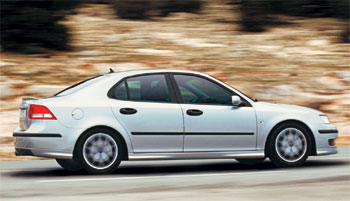 A five -speed machine makes it possible to choose gears by hand, including as an option - buttons on the steering wheel. However, I don’t want to use this yet. The adaptive program reacts relatively quickly to the driving style and after two or three intensive accelerations passes into dynamic mode. It calms down equally quickly. The gear shifts themselves occur smoothly and almost imperceptibly. The mechanics also pleased with the optimal moves of the lever and successfully selected efforts on it: the lever is not empty, but there is no need to strain.
A five -speed machine makes it possible to choose gears by hand, including as an option - buttons on the steering wheel. However, I don’t want to use this yet. The adaptive program reacts relatively quickly to the driving style and after two or three intensive accelerations passes into dynamic mode. It calms down equally quickly. The gear shifts themselves occur smoothly and almost imperceptibly. The mechanics also pleased with the optimal moves of the lever and successfully selected efforts on it: the lever is not empty, but there is no need to strain. In general, the pursuit of my smile for Saab was successful. The new 9-3, perhaps, most accurately corresponds to my ideas about the driver for the driver. Not least by what seems to be the best choice for any situation: in the city it is just as pleasant to go slowly as on the highway - quickly. He does not provoke and does not force, he just allows the driver to do exactly what he wants.
However, we will not be idealists. It is strange that the Saabovtsy did not take into account so attentive to the little things that the shelf made of light material on a sunny day is amazingly reflected in the rear window, making it difficult to a review through the inner mirror.
Text Valery Chusov, photo of the author and Saab
Model/Modification Saab 9-3 2.0t Arc Saab 9-3 2.0t Aero
Manufacturer/country Saab Automobile Ab/Sweden Saab Automobile Ab/Sweden
BODY
Type sedan sedan
Number of doors/places 4/5 4/5
ENGINE
Type of gasoline with electronic injection, turbocharged gasoline with electronic injection, turbocharged
Boarding pressure, atm 0.7 0.85
Front location, transversely in front, transversely
Working volume (cubic cub) 1998 1998
Number/location of cylinders 4/in -line 4/in -line
Power, kW (L.S.) at about./Min. 129 (175) at 5500 147 (210) at 5500
Moment (nm at about./Min.) 265 at 2500 300 at 2500
TRANSMISSION
Front front drive
The gearbox is mechanical, 5-speed mechanical 6-speed
SUSPENSION
The anterior independent type Mcphereson, the transverse stability stabilizer Independent type Mcpherson, the reptile stabilizer
The rear independent, four -leaf, with a steaming effect, the reptile stabilizer is independent, four -leaf, with a steaming effect, a reptile stabilizer
STEERING
Type gear rack with a hydraulic booster gear-rake with a hydraulic booster
Min. Diameter of turn (m) 10.8 10.8
The number of rulings of the steering wheel from the stop to the stop 2.97 2.97
Brakes
Front/rear circular ventilated/disk ventilated/disk disk
ABS 4-channel, the system of distribution of brake force along the axes (EBD) and in turning (CDC), help with emergency braking, anti-boom system (TCS), ESP (option) 4-channel, system distribution system for axes (EBD) and In a turn (CDC), help with emergency braking, anti -wings system (TCS), ESP (option)
Dimensions/volumes/weight
Length/width/height (mm) 4635/1762/1466 4635/1762/1466
Wheel base (mm) 2675 2675
Equipped mass (kg) 1450 1460
Tires 205/50 R16 215/45 R17
Disks 6.5j x 16 7j x 17
Dynamic characteristics
Maximum speed (km/h) 225 235
Acceleration to 100 km/h (sec.) 8.5 7.5
Economy
Average fuel consumption (l/100 km) 8.5 8.5
The price in Moscow (approximately) from $ 27 thousand from $ 27 thousand.
Source: "Autopilot"
Video crash tests Saab 9-3 1998-2002
Saab test drives 9-3 1998-2002
Saab Crash Test 9-3 1998-2002
Krassh Test: Detailed Information26%
Driver and passengers
4%
Pedestrians

